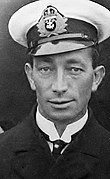Wikipedia:Main Page history/2023 October 11b
From today's featured article
William Edward Sanders (1883–1917) was a New Zealand recipient of the Victoria Cross (VC), the highest British and Commonwealth combat award for gallantry. He took up a seafaring career in 1899 and earned a master's certificate in 1914, after the outbreak of World War I. He served on troopships until April 1916, when he was commissioned in the Royal Naval Reserve. He was appointed second in command of Helgoland, a Q-ship operating against German submarines. He was given his own command, HMS Prize, in February 1917. Sanders was awarded the VC for his actions while on his first patrol as captain, when Prize engaged and drove off a German U-boat that had attacked and damaged the ship. He was killed in action when Prize was sunk by a U-boat on her fourth patrol. His VC is currently held by the Auckland War Memorial Museum. His memorials include the Sanders Cup, a sailing trophy for 14-foot (4.3 m) yachts. (Full article...)
Did you know ...
- ... that the FBI set up temporary offices in a museum on an aircraft carrier (pictured) while investigating the 9/11 terrorist attacks?
- ... that Bill Duplissea has been said to have the "best eyes in baseball"?
- ... that Episode 2351 of the Australian soap opera Home and Away was filmed in England, marking the first time the serial was filmed overseas?
- ... that Irish writer Dave Rudden has written a juvenile fantasy trilogy as well as several stories in the Doctor Who universe?
- ... that to portray a child abductor in A Friend of the Family, Jake Lacy took inspiration from the fearlessness and charisma of Danny Ocean and Steve McQueen?
- ... that Thomas Mancuso showed how deaths among factory workers could be understood by looking at social security data?
- ... that the royal chronicles report that the Kingdom of Ava mobilized nearly 300,000 troops for one invasion, but they probably only mobilized around a tenth of that?
- ... that the katydid-like fossil Republicopteron douseae possibly could not sing?
In the news
- Three earthquakes (aftermath pictured) leave at least 1,000 people dead in Herat, Afghanistan.
- Kelvin Kiptum breaks the men's marathon world record in the Chicago Marathon.
- In motorsport, Max Verstappen wins the Formula One World Championship.
- Israel declares a state of war after Hamas and other Palestinian militant groups launch a series of attacks from the Gaza Strip that has left hundreds dead.
On this day
October 11: Feast day of Saint James the Deacon (Anglicanism); National Coming Out Day
- 1311 – The peerage and clergy of the Kingdom of England published the Ordinances of 1311 to restrict King Edward II's powers.
- 1852 – The University of Sydney (pictured), Australia's oldest university, was inaugurated two years after being established by the University of Sydney Act.
- 1865 – The Morant Bay rebellion, led by Paul Bogle and George William Gordon, began in Jamaica; after protestors burned down the courthouse, it was brutally suppressed by Governor Edward John Eyre.
- 1937 – Edward, Duke of Windsor, and Wallis, Duchess of Windsor, arrived at Berlin Friedrichstraße station to begin a tour of Nazi Germany, where they were greeted with Nazi salutes and dined with high-ranking members of the state apparatus.
- 1973 – Typhoon Nora, the fourth-most intense tropical cyclone on record, dissipated after killing 40 people and leaving more than a million homeless across Taiwan and the Philippines.
- Huldrych Zwingli (d. 1531)
- Casimir Pulaski (d. 1779)
- Jean Alexander (b. 1926)
- Sawao Katō (b. 1946)
Today's featured picture

|
|
AG Carinae is a luminous blue variable star in the constellation Carina. It is one of the most luminous stars in the Milky Way, although its great distance from Earth (20,000 light-years) and intervening interstellar dust mean that the star is not usually visible to the naked eye; its apparent brightness varies erratically between magnitude 5.7 and 9.0. Apparently in a transitional phase between a massive class-O blue supergiant and a Wolf–Rayet star, AG Carinae is highly unstable and suffers from erratic pulsations, occasional larger outbursts, and rare massive eruptions. The star is surrounded by a nebula of ejected material at a distance of 0.4 to 1.2 parsecs (1.3 to 3.9 light-years). The nebula contains around 15 solar masses of material, all lost from the star around 10,000 years ago. This photograph of AG Carinae and its surrounding nebula was taken by the Hubble Space Telescope in 2021, as one of its anniversary images. Photograph credit: NASA, ESA and the Space Telescope Science Institute
Recently featured:
|
Other areas of Wikipedia
- Community portal – The central hub for editors, with resources, links, tasks, and announcements.
- Village pump – Forum for discussions about Wikipedia itself, including policies and technical issues.
- Site news – Sources of news about Wikipedia and the broader Wikimedia movement.
- Teahouse – Ask basic questions about using or editing Wikipedia.
- Help desk – Ask questions about using or editing Wikipedia.
- Reference desk – Ask research questions about encyclopedic topics.
- Content portals – A unique way to navigate the encyclopedia.
Wikipedia's sister projects
Wikipedia is written by volunteer editors and hosted by the Wikimedia Foundation, a non-profit organization that also hosts a range of other volunteer projects:
-
Commons
Free media repository -
MediaWiki
Wiki software development -
Meta-Wiki
Wikimedia project coordination -
Wikibooks
Free textbooks and manuals -
Wikidata
Free knowledge base -
Wikinews
Free-content news -
Wikiquote
Collection of quotations -
Wikisource
Free-content library -
Wikispecies
Directory of species -
Wikiversity
Free learning tools -
Wikivoyage
Free travel guide -
Wiktionary
Dictionary and thesaurus
Wikipedia languages
This Wikipedia is written in English. Many other Wikipedias are available; some of the largest are listed below.
-
1,000,000+ articles
-
250,000+ articles
-
50,000+ articles




